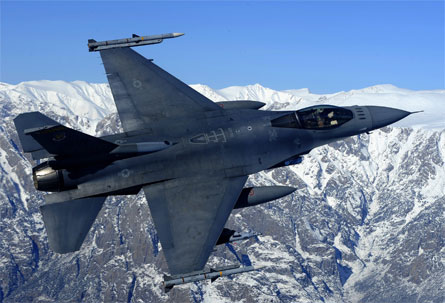As concerns grow that the US Air Force is losing its air-power edge over potential rivals, the service's leadership has decided that hundreds of its oldest Lockheed Martin F-16s can remain in service for nearly 10 more years with minimal investment.
"With respect to the early blocks, our assessment is there is engineering analysis to support going from 8,000h of expected service life to over 10,000 with just enhanced depot maintenance procedures and maybe some very low-cost adjustments that we would make only on an airframe-by-airframe basis," secretary of the air force Michael Donley said during the Air Warfare Symposium in Orlando, Florida on 18 February. The F-16's life could be extended to around 10,800 flight hours, he adds.
Air force aircraft usually consume about 300 flight hours each year in peacetime. Increasing the expected service life of an airframe by 2,800 flight hours potentially extends the expected service by more than nine years.
 |
|---|
© USAF |
Keeping more of the USAF's 1,200-strong F-16 inventory out of retirement is necessary because of the recent slowdown of the Lockheed F-35 Lightning II, which is now scheduled to enter service in fiscal year 2016.
The air force wants to minimise how much it spends on legacy fighters at the same time that it ramps up spending on the replacement type.
"The strategic intent is to get F-35 production up as quickly as possible," Donley says.
Tweaking maintenance procedures will only work to extend the service life of Block 30-standard F-16s. The air force also is conducting long-term static tests to determine the service life extension requirements for the Block 40/50 fleet, but a decision to launch such a programme is not required until FY2015.
"For the later Block 40s and higher we're undertaking an engineering analysis to look more carefully at structural issues and also assess capability issues to evaluate what we might want to do in the future," Donley says.
In addition to evaluating the structure of the legacy F-16s, the Air Combat Command (ACC) also is considering capability upgrades.
"We realise that we will need to take F-16s and make some service life extensions to not only the airframe but maybe the avionics," says ACC chief Gen William Fraser.
Among the options under consideration is to replace the current radar with an active electronically scanned array (AESA), with the Northrop Grumman scalable agile beam radar and Raytheon advanced combat radar as two possibilities.
The USAF is grappling with concerns about its ability to remain the world's dominant air power as its fighter fleet shrinks and becomes more expensive with the introduction of more capable fifth-generation fighters, such as the F-35 and Lockheed F-22.
"We're not going to be able to outnumber people any more," says Gen Gary North, chief of Pacific Air Forces. "Our air force is very expensive. We've got to ensure that what we've got works all the time."
Source: Flight International
















